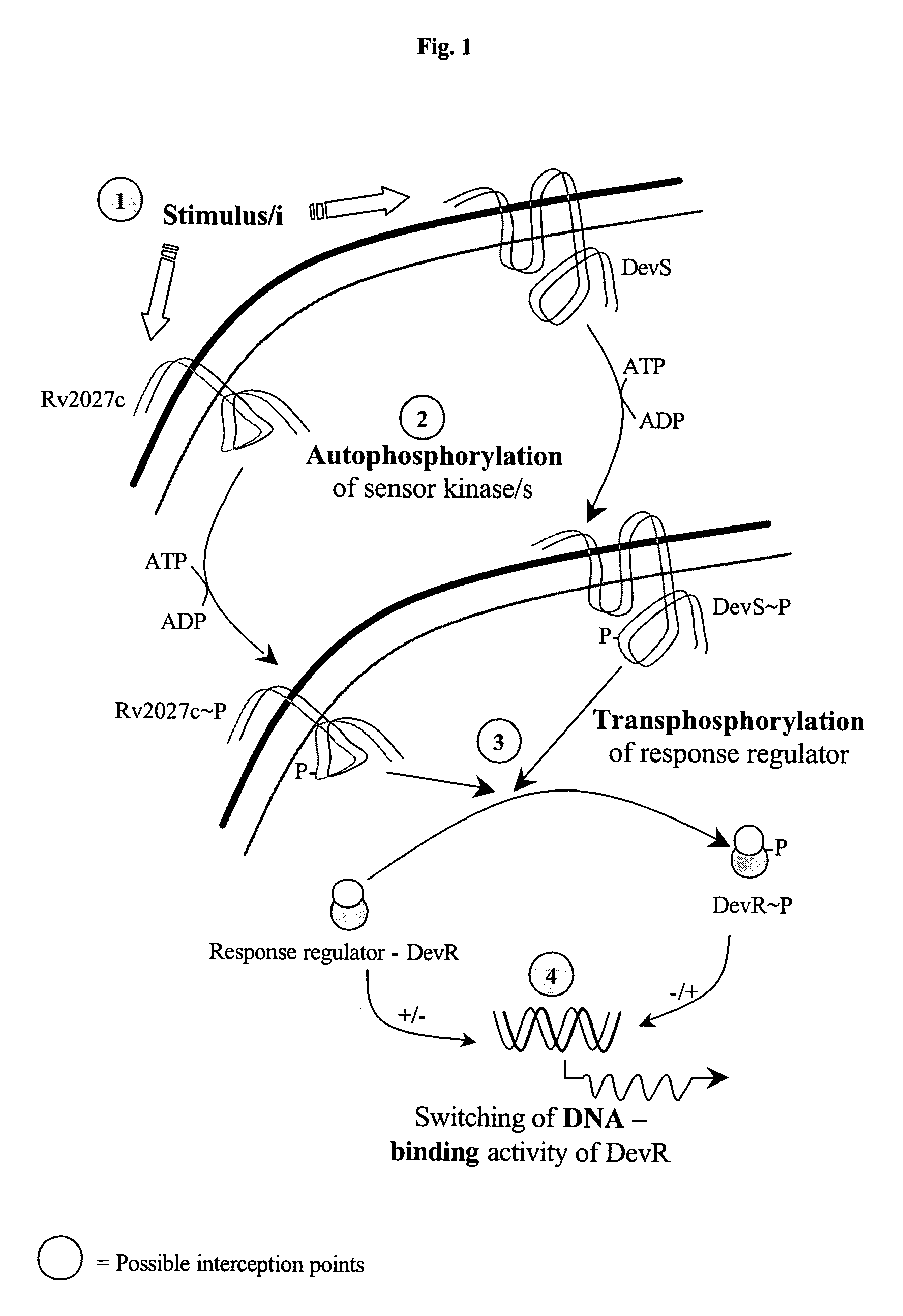Screening method for developing drugs against pathogenic microbes having two-component system
a technology of pathogenic microorganisms and screening methods, applied in the field of screening methods, can solve the problems of no new intervention reported, no functional dissection of the mycobacterial regulatory network cascade involving a two-component system in general, and the devr-devs system in particular
- Summary
- Abstract
- Description
- Claims
- Application Information
AI Technical Summary
Benefits of technology
Problems solved by technology
Method used
Image
Examples
example 1
Cloning, Overexpression and Purification and Refolding of DevR, DevS and Rv2027c and Their Single Domain Derivative / s and Mutant Variant Proteins
A. Cloning of DevR, DevRN145, DevS201, DevS578 and Rv2027194 and Generation of Their Single Domain and Mutagenic Derivatives
[0134]All routine recombinant DNA work was performed as described (Sambrook and Russell, 2001). M. tuberculosis H37Rv DNA was prepared by boiling cells in the presence of 0.1% Triton X-100 for 25 minutes at 95° C. and the supernatant recovered after centrifugation was used as a source of template DNA in PCR. Full length devR, N-terminal truncated devS201, full length devS578 and N-terminal truncated Rv2027194 genes were amplified from M. tuberculosis DNA by PCR using Pfu DNA polymerase and primers that contain restriction enzyme sites engineered in them (FIG. 2, Table 1).
[0135]For the expression of N-terminally His6-tagged DevR protein, the devR PCR product was digested with NdeI and SalI and after blunting with T4 DNA...
example 2
Studies of Autophosphorylation Activity of DevS and Rv2027c Proteins
[0163]DevS201, DevS578 and Rv2027194 proteins and their mutant derivatives DevS201-H395Q, DevS201-H397Q, DevS201-H397A, DevS201-N503D and Rv2027194-H392Q were subjected to autophosphorylation with [α32P] ATP as phosphodonor molecule.
[0164]Purified and refolded protein / s (15 μM of DevS201 or Rv2027194 or their mutagenic variants thereof and 2.5 μM of DevS578) were incubated with 5 μCi of [α32P]ATP (5000 Ci / mmol, BRIT, CCMB campus, Hyderabad, India) in 10 μl reaction buffer (50 mM Tris.HCl, pH 8.0, 50 mM KCl, 10 mM MgCl2, 50 μM ATP) at 25° C. for the designated periods of time. After which the reactions were terminated by addition of 5 μl 3× sample buffer containing 250 mM Tris.HCl, pH 6.8, 10% glycerol, 1% SDS, 280 mM β-mercaptoethanol, 0.01% bromophenol blue.
[0165]The samples were immediately frozen on chilled ethanol bath and stored at −70° C. until just prior to analysis by SDS-PAGE.
[0166]Prior to SDS-PAGE analysi...
example 3
Phosphorylation Activity of DevR
[0174]To study the phosphotransfer reaction, DevS201 / Rv2027194 (15 μM) or DevS578 (5 μM) was phosphorylated for 30 min as described above. Subsequently, DevR / DevRN145 protein (20 μM) was added to 32P phosphorylated sensor kinases. At indicated time points, aliquots were removed and stored at −70° C. until analysis. Subsequently, the samples were analysed on 15% SDS-PAGE and subjected to autoradiography as described for autophosphorylation reactions.
[0175]The phosphorylation assays with the DevRN145 and DevR mutant proteins were performed under identical conditions as described for the wild type DevR protein. The findings are provided below:[0176]1. Phosphorylation of DevR / DevRN145 by phosphotransfer from DevS578, DevS201 and Rv2027194 occurred very rapidly. Within 2-5 minutes of the initiation of reaction, half of the radioactivity incorporated in the sensor kinases was transferred to DevR (FIGS. 9A, B, C, D, E). These rapid kinetics would be useful f...
PUM
| Property | Measurement | Unit |
|---|---|---|
| volume | aaaaa | aaaaa |
| pH | aaaaa | aaaaa |
| pH | aaaaa | aaaaa |
Abstract
Description
Claims
Application Information
 Login to View More
Login to View More - R&D
- Intellectual Property
- Life Sciences
- Materials
- Tech Scout
- Unparalleled Data Quality
- Higher Quality Content
- 60% Fewer Hallucinations
Browse by: Latest US Patents, China's latest patents, Technical Efficacy Thesaurus, Application Domain, Technology Topic, Popular Technical Reports.
© 2025 PatSnap. All rights reserved.Legal|Privacy policy|Modern Slavery Act Transparency Statement|Sitemap|About US| Contact US: help@patsnap.com



